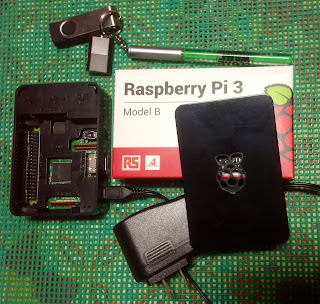by J.B. Wylzan
First, you need the following items:
- MicroSD card with preloaded NOOBS (or load it yourself here)
- HDMI monitor
- HDMI cable
- USB keyboard and mouse
- 2.5A microUSB power supply
- Ethernet cable (for internet connection)
A) Install GUI Linux:
1. Insert all of the items above to the raspberry pi board.
2. Insert the microSD card (this is your hard drive)
3. Power it up by connecting the 2.5A power adapter
4. Once the NOOBS is running, select the "Raspbian" as your operating system
5. When done, shut it down properly using the terminal editor
-type: sudo shutdown -h now
To Setup as a Webserver:
B) Install Apache:
Apache is a popular web server application you can install on the Raspberry Pi to allow it to serve web pages.
On its own, Apache can serve HTML files over HTTP, and with additional modules can serve dynamic web pages using scripting languages such as PHP.
Install the apache2 package by typing the following command into the terminal:
sudo apt-get install apache2 -y
Test the web server
By default, Apache puts a test HTML file in the web folder. This default web page is served when you browse to http://localhost/ on the Pi itself, or http://192.168.1.10 (whatever the Pi's IP address is) from another computer on the network.
To find out the Pi's IP address, type hostname -I at the command line.
Browse to the default web page, either on the Pi or from another computer on the network, and you should see the following:
Changing the default web page
This default web page is just a HTML file on the filesystem. It is located at /var/www/html/index.html.
Note: The directory was /var/www/html in Raspbian Jessie
Navigate to this directory in the Terminal and have a look at what's inside:
cd /var/www/html
ls -al
As you can see, by default the html directory and index.html file are both owned by the root user, so you'll need to use sudo to edit them.
Try editing this file and refreshing the browser to see the web page change.
Press Ctrl + X and hit Enter to save and exit.
C) Install PHP:
PHP is a preprocessor; it's code that runs when the server receives a request for a web page. It runs, works out what needs to be shown on the page, then sends that page to the browser. Unlike static HTML, PHP can show different content under different circumstances. Other languages are capable of this, but since WordPress is written in PHP, that's what we need to use this time.
Install the PHP and Apache packages with the following command:
sudo apt-get install php5 libapache2-mod-php5 -y
Test PHP
Create the file index.php:
sudo nano index.php
Put some PHP content in it:
<?php echo "hello world"; ?>Now save the file. Next delete index.html because it takes precendence over index.php:
sudo rm index.htmlRefresh your browser. You should see "hello world". This is not dynamic but it is still served by PHP. If you see the raw PHP above instead of "hello world", reload and restart Apache like so:
sudo service apache2 restartOtherwise try something dynamic, for example:
<?php echo date('Y-m-d H:i:s'); ?> <?php phpinfo(); ?> MySQL (pronounced My Sequel or My S-Q-L) is a popular database engine.
Like PHP, its overwhelming presence on web servers enhanced its popularity. This is why projects like WordPress use it, and why those projects are so popular.
Install the MySQL Server and PHP-MySQL packages by entering the following command into the terminal:
sudo apt-get install mysql-server php5-mysql -y
When installing MySQL you will be asked for a root password. You'll need to remember this to allow your website to access the database.
Now restart Apache:
sudo service apache2 restart
E) Install Alexa:
Step 1: Setting up your Pi
Step 2: Register for an Amazon developer account
Step 3: Create a device and security profile
- Allowed Origins: https://localhost:3000
- Allowed Return URLs: https://localhost:3000/authresponse
- cd Desktop
- git clone https://github.com/alexa/alexa-avs-sample-app.git
- cd ~/Desktop/alexa-avs-sample-app
- nano automated_install.sh
- cd ~/Desktop/alexa-avs-sample-app
- . automated_install.sh
Terminal 1
- cd ~/Desktop/alexa-avs-sample-app/samples
- cd companionService && npm start
- cd ~/Desktop/alexa-avs-sample-app/samples
- cd javaclient && mvn exec:exec
- cd ~/Desktop/alexa-avs-sample-app/samples
- cd wakeWordAgent/src && ./wakeWordAgent -e kitt_ai
Step 9: How to Log Out of the Sample App
To log out of the AVS java sample app you must clear your sessionId in /samples/javaclient/config.json, and delete your refresh_tokens file in the /samples/companionService folder. Otherwise, the sample app will authenticate on each reboot.
Solution:
Follow these instructions to log out of the AVS java sample app:
Quit the AVS java sample app (CTRL + C).
Open /samples/javaclient/config.json and clear your sessionId. It should look like this:
"sessionId": ""
Delete the refresh_tokens file in samples/companionService.
The next time you log in you will be prompted to authenticate.
Reference: github.com/alexa/alexa-avs-sample-app/wiki/Raspberry-Pi
NOTICE: Articles on this site are composed on random thoughts. The transcript may not be in its final form. It maybe updated or even revised in the future.
"Everything is a switch, each one can be turned ON and OFF." ~ Joey Lawsin
Disclaimer: We shall not be liable for any loss or damage of whatever nature - direct, indirect, consequential, or otherwise - which may arise as a result of your use of any information on this website. However, if you are interested in using any of the projects for personal or educational purposes, please inform the author by email.
PPublic Domain Notice: Copyright (c) 2000. All rights reserved. This article is part of a book entitled iHackRobot. Copies are welcome to be shared or distributed publicly as long proper citations are observed. Please cite as follows: Biotronics: The Silver Species, Joey Lawsin, 1988, USA.
==================================================================
Patent Pending. 2000 © ®
A L.A.W.S.I.N. Educational Production


